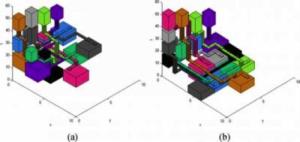Unique pocket-sized lab could provide doctors immediate test results, reduce costs for budget-strapped clinical laboratories, and serve as a lab-testing tool for doctors working in remote areas
For almost two decades, developers have touted the potential of lab-on-a-chip technology to play a greater role in clinical laboratory testing. Now the latest twist on this technology story is that computer engineers are using the power of computer-aided design (CAD) to develop innovative lab-on-a-chip (LOC) designs.
This innovative work was created by two computer engineers from Michigan Technological University (MTU). Working together, T. Shiyan Hu, Ph.D., Associate Professor of Electrical and Computer Engineering at MTU, and doctorate student Chen Liao have created two computer-generated configurations for routing a droplet of blood or other bodily specimen through multiple LOC channels. Their invention would facilitate running dozens of different diagnostic tests, from HIV to diabetes, on a single LOC.
Computer-Aided Design is Key to Developing Multi-test Lab-on-a-Chip
Generally a LOC can run no more than a test or two, because the chips are designed manually, noted Hu in a scientific paper published by IEEE Transactions on NanoBioscience. He noted that if LOCs are made using computer-aided design, (CAD), dozens of tests could be run with a single drop of blood or other bodily specimen.
Microfluidic LOCs are widely utilized in biochemical analysis and human health studies because of their high-detection accuracy, high-timing efficiency, and low cost. The increased design complexity of LOCs necessitates the use of CAD methodology in lieu of the classical manual design methodology, wrote the authors of the journal article.
“We have developed software to design the hardware,” Hu said in a Michigan Tech News story. He noted that his work focused on routing the droplet of blood through each test on the chip efficiently, while avoiding any chip contamination.

Using computer-aided design, T. Shiyan Hu, Ph.D. (pictured above), Associate Professor of Electrical and Computer Engineering at Michigan Technological University, created software to produce the first multi-test lab-on-a-chip that can do any routine diagnostic tests that are currently done in conventional medical labs. (Photo copyright Michigan Technology University.)
Physical-Level Synthesis Flow Facilitates Maze-based Routing Technique
A key part in using computer-aided design to create a lab-on-a-chip is physical-level synthesis, said the LOC developers in the journal article. This includes LOC placement and routing. Placement is what determines the physical location and starting time of each operation of the chip, while routing transports each droplet from the source to the destination.
When designing a lab-on-a-chip for multiplex testing, such factors as variation, contamination, and defect must be considered, emphasized the developers of this pocket-sized, multi-test LOC. Their work designed a physical-level synthesis flow that simultaneously considers variation, contamination, and defect of the LOC design.

(a) (left), is one routing solution for vitro3–1 using ROUTE without V. The droplets are transported from the sources to the destinations. This illustration shows a pair of source and destination and the corresponding routing, which are painted by the same color. (b) (right) shows the routing solution for vitro3–1 using ROUTE with V. (Image copyrights IEEE Transactions on NanoBioscience.)
Multi-Test LOC is Cheap to Make and More Accurate Than a Medical Lab
While it took four years for Hu and Liao to develop the software, they say that manufacturing the multi-test LOC would be quick and inexpensive. Hu noted that the materials are cheap and the test results more accurate than a conventional clinical laboratory.
“In a very short time, you could test for many conditions,” he said. “This really would be an entire lab-on-a-chip.”
Hu and Liao ultimately plan to fabricate their design into a real biochip using their own software.
Device May Revolutionize Doctor Practices and Reduce Lab Test Costs
The portability of point-of-care testing (POC) enabled by this type of LOC technology has long been recognized as having the potential to revolutionize how doctors practice medicine in the field. It might allow them to carry such credit-card-sized devices in their coat pockets when seeing patients and get instant medical lab test results, without the need to send specimens to a medical laboratory facility and waiting overnight for the results.
However, it should also be noted that lab-on-a-chip technology could also eventually be a boon for budget-strapped medical laboratories. By enabling the laboratory to perform testing more inexpensively, LOC designs enabled by CAD could allow labs to reduce staff or focus staff on more complex lab testing services that generate greater revenues than routine lab tests.
Of equal significance, such LOCs would be an invaluable tool for field hospitals, military doctors, and medics, as well as medical professionals conducting outreach programs in rural areas or developing countries, pointed out the Michigan Tech Times report.
—By Patricia Kirk
Related Information:
Physical-Level Synthesis for Digital Lab-On-a-Chip Considering Variation, Contamination, and Defect
A lab in your pocket: Using CAD to load dozens of tests on a lab-on-a-chip



